Excerpts from Jim Conrad's
Naturalist Newsletter
entry dated April 2, 2022, notes from a field trip to Sierra de Rincón, one straight-line km WNW of Laguna de Servín, oak-pine forest at 2700m (8860ft), N20.27°, W 100.28°, southwestern Querétaro state, MÉXICO
NETLEAF OAK FLOWERING
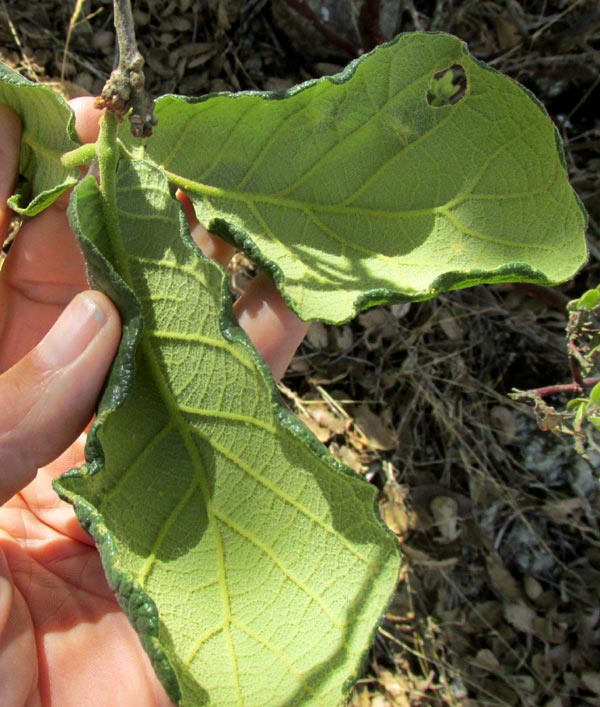
Descending from the little alpine-like community of Laguna de Servín, the driver had to make a pit stop, so I jumped out and quickly took photos of the nearest tree, the dominant tree on this deeply eroded, west-facing slope, hoping later to identify it. Just for this little pile of mountains, Sierra de Rincón, 9 oak species have been documented. Above, the first snapshot shows silvery-yellow, densely hairy undersides of freshly emerged leathery leaves on the 5m tall (16ft) tree. Notice how the leaves' margins tend to curl under, and that the visible upper surface is darker and much wrinkled, or rugose. Also, the leaves' margins, while irregularly crinkled, are not lobed and don't bear any signs of bristles or pointed tips. The blades are wider toward to outer end than the base, or obovate, and the blades are "eared" with shallow lobes extending toward the stem.
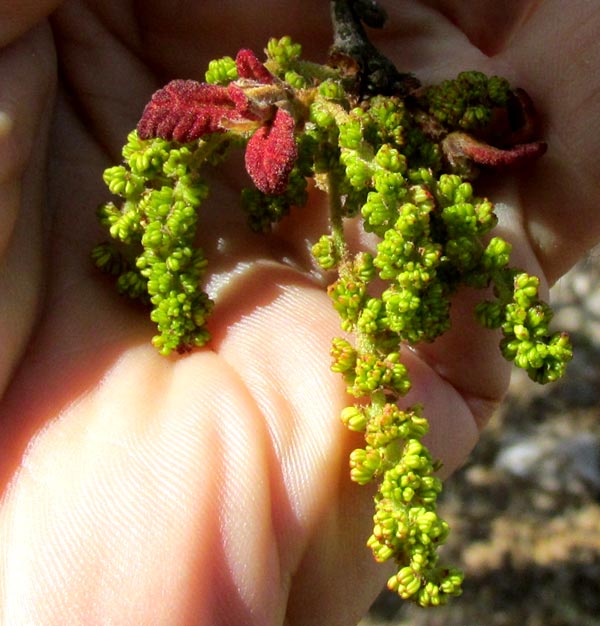
The tree still bore a few of last season's parchment-like leaves, and this season's new leaves as large as the above appeared only here and there. Numerous twigs ended with what's shown above: tiny red leaves with yellow, catkin-like aments of dangling male flowers. Compared to the aments of other oak species I've encountered, these aments were relatively few-flowered, short and thick.
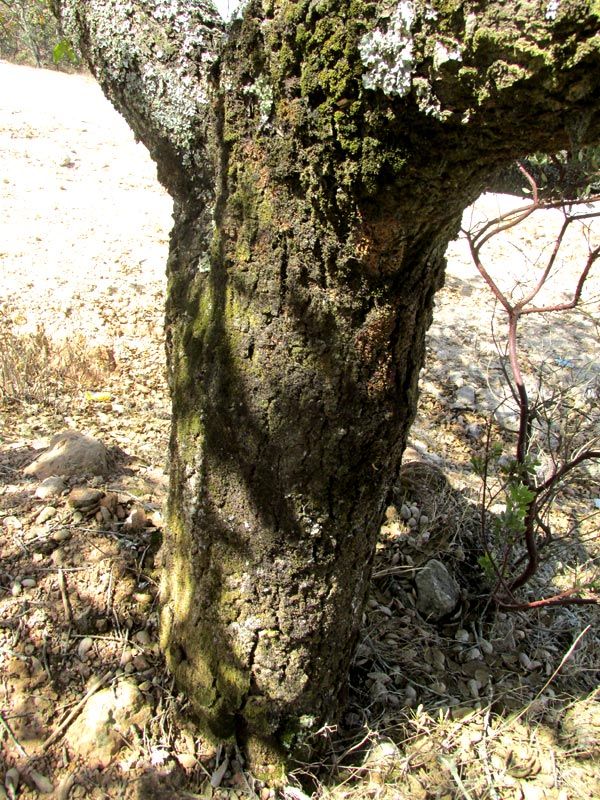
The tree's trunk also was short and thick, and nicely encrusted with lichens and moss, much in contrast to woody plants in the hot, arid scrublands farther downslope.
Not having time to find last season's acorns, which would have helped with the identification, with these shots to work form, in the end it came down to choosing which it was of two of the nine species listed for Sierra de Rincón: Quercus obtusata or Quercus rugosa. The two species are closely related, and can hybridize with one another.
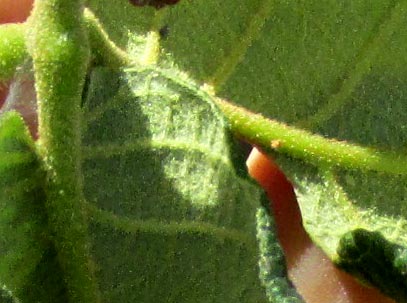
Technical descriptions of the two species are largely the same, as are the elevations at which they occur, and their flowering periods. At the right a close-up of leaf undersurfaces reveals dense, pale hairiness on both the blade surface and veins. This is about the same for both species. However, Q. obtusata leaves are described as having predominantly 11-12 secondary veins on each side of a leaf, while Q. rugosa leaves predominantly have only 8-9, though sometimes the vein number completely overlaps. In our first leaf picture, veins number 8 or 9, so that's a weak vote for Q. rugosa. Also, Q. obtusata leaves are described as mostly 4-8 cm wide, with Q. rugosa leaves mostly 11-15cm wide, though sometimes there's considerable overlap, so that's another vote for Q. rugosa, since our leaves appear to be relatively large.
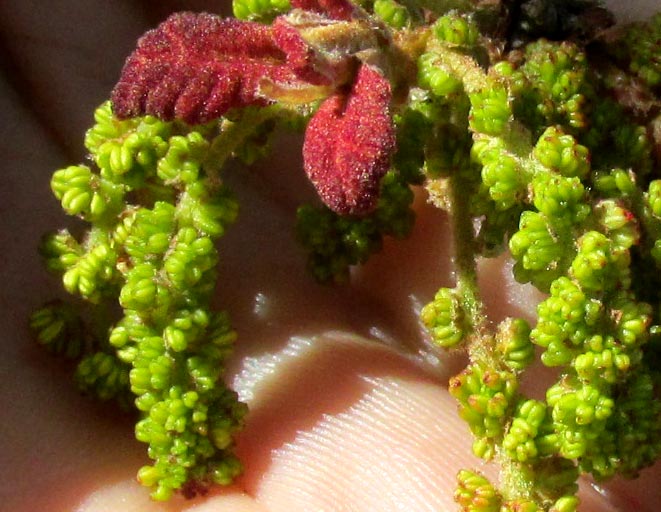
The literature also reports that Q. obtusata aments bear "numerous" flowers, with each flower producing 6-8 stamens, while Q. rugosa aments bear only 20-26 flowers, with each flower producing about 10 stamens. A close-up of our emerging flowers at the left seems to show as many as 10 stamens in some flowers, so the flower number per ament and the stamen number per flower both weakly suggest Q. rugosa. Add to that Q. obtusata being endemic only to central and southern Mexico, while Q. rugosa occurs from the US's southwestern border states south to Guatemala, indicating a greater range of adaptability, and the impression that we have Q. rugosa grows. All our indicators favor Q. rugosa, though there's always occasional overlap of features with Q. obtusata.
So we'll call this QUERCUS RUGOSA, which field guides in the US sometimes refer to as the Netleaf Oak. In Spanish, numerous common names are used, though most people just call them robles, a general term for deciduous oaks, the term encina applying to evergreen oak species.
Of course oaks in general are famous for their nutritious acorns which both wildlife and traditional human societies relished and depended on. One Spanish name for this species is Quebracho, loosely translated as "Ax Breaker," indicating both the species' durability and firewood value. Oaks contain large amounts of tannic acid, used to tan hides, and as an astringent in traditional medicine. Cut yourself, and a dark infusion of oak bark will cause the capillaries to pucker and stop bleeding.
notes appended to the April 12, 2015 Newsletter describing a visit to San Juan de Monte Ecological Reserve on the south side of Las Vigas, on the northern slope of Cofre de Perote Volcano, at about 8100ft (2500m) in elevation, Veracruz state, MÉXICO
FEMALE FLOWERS
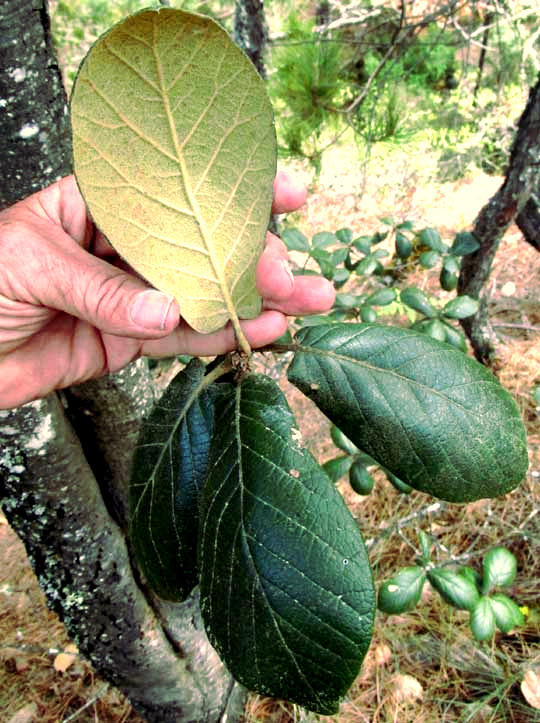 About an hour's hike southward from Las Vigas, thus upslope toward Cofre de Perote Volcano well south of town, and hidden by forested foothills, I camped at the edge of a piney forest developed on thin soil of black basalt rock. The pines are all the same height, maybe 30 years old. On a rocky cliff overlookingf a shallow, steep-walled valley, some youngish oaks maybe 15ft tall (5m) appeared. At the right you can see their leathery, round-tipped, broadly-eared based leaves with very hairy undersurfaces and shiny, dark green surfaces.
About an hour's hike southward from Las Vigas, thus upslope toward Cofre de Perote Volcano well south of town, and hidden by forested foothills, I camped at the edge of a piney forest developed on thin soil of black basalt rock. The pines are all the same height, maybe 30 years old. On a rocky cliff overlookingf a shallow, steep-walled valley, some youngish oaks maybe 15ft tall (5m) appeared. At the right you can see their leathery, round-tipped, broadly-eared based leaves with very hairy undersurfaces and shiny, dark green surfaces.
I looked in vain for acorns below the tree, but I did notice some female flowers -- future acorns -- with well exposed, Y-shaped stigmas with curling arms, shown below:
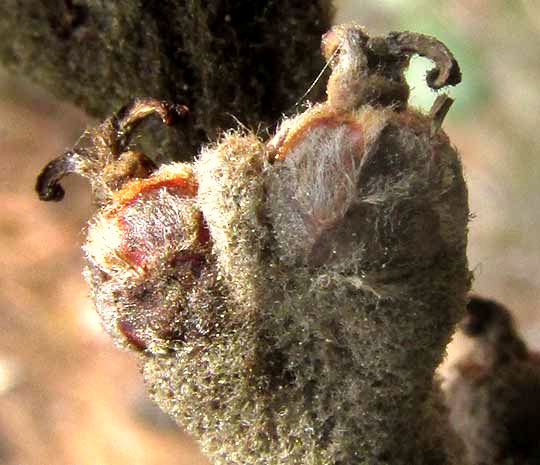
entry from field notes dated June 29, 2022, taken in an oak forest atop Cerro de la Cruz, elevation ~2885m (~9465 ft), rising on the south side of the community of El Pinar, Amealco de Bonfil, Querétaro, MÉXICO, (~N20.17°, ~W100.17°)
MOUNTAINTOP TREES
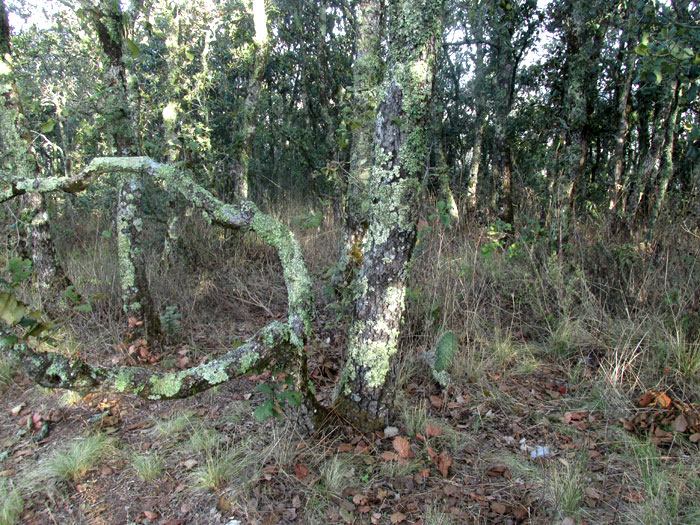
Atop a narrow, windswept ridge maybe 15m below the peak of Cerro de la Cruz, a stand of old looking but small oaks looked like something new to me. The habitat is shown above. These trees' leaves were smaller than those seen on other oaks in the region with blades of similar shape:
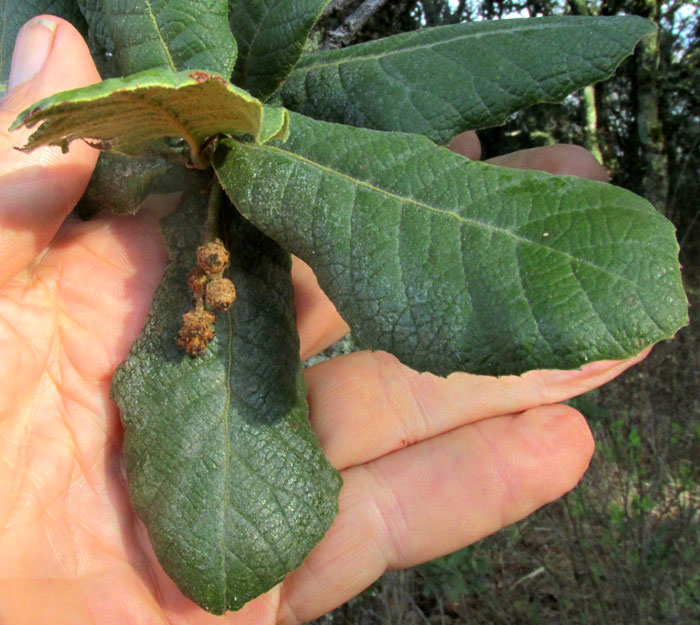
The long peduncle on which at least seven female flowers were maturing into acorns was noteworthy, as well as the blades' strongly down-turning margins and undersurfaces densely covered with silvery, maybe slightly reddish-hewed hairiness:
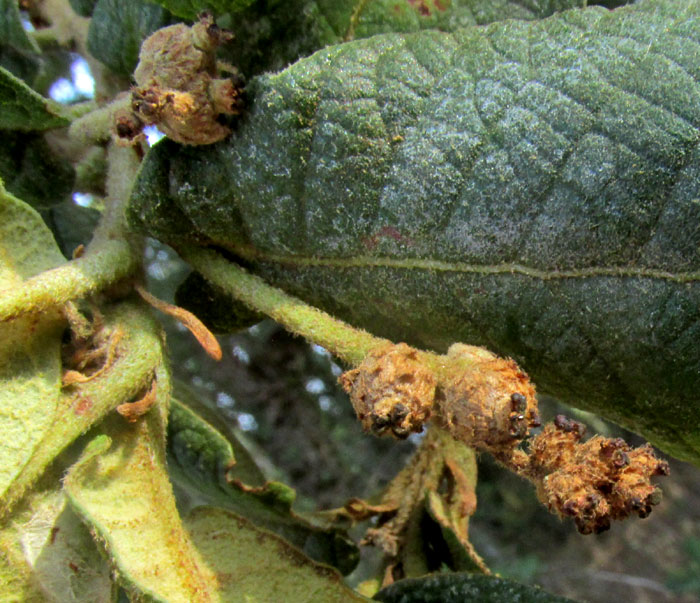
Below are remains of last season's acorns:
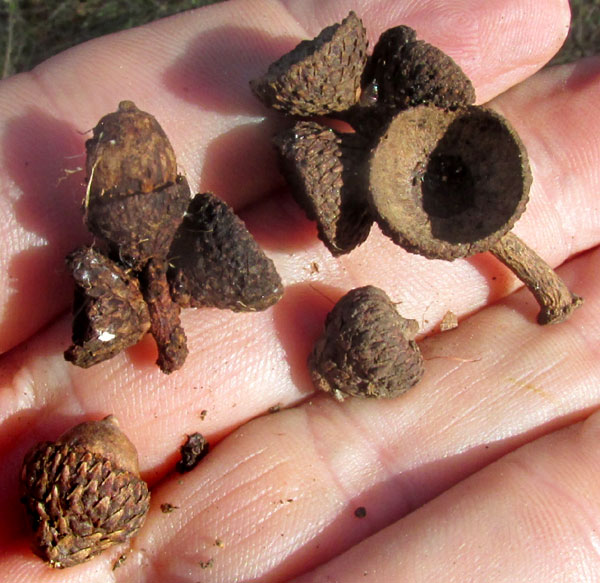
With such small leaves, at first I thought the trees were Quercus greggii, but then I read in the Flora del Bajío that the female flowers of Q. greggii aggregate only in groups of two to four, and that the species' acorns are borne on peduncles only up to four mm long.
That brought us back to the Netleaf Oak, which in our region occurs up to 3200m in elevation, and whose acorns can adorn peduncles up to 8cm long (3 inches).
This is an especially adaptive, variable species. In fact, on another tree maybe 100m lower down in the valley, the following was observed, not only a well formed developing acorn, but also showing that the hairs can have a definite rusty hue.
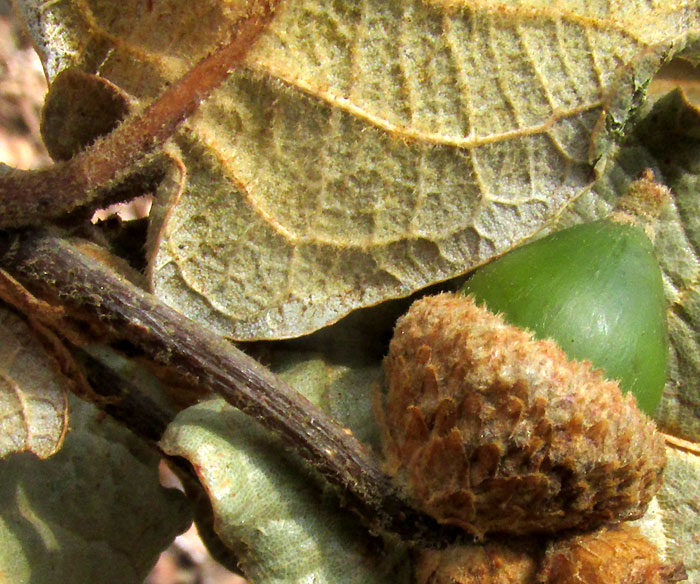
entry from field notes dated July 1, 2022, taken in an oak forest atop Cerro de la Cruz, elevation ~2750m (~9000 ft), rising on the south side of the community of El Pinar, Amealco de Bonfil, Querétaro, MÉXICO, (~N20.17°, ~W100.17°)
LONG PEDUNCLES
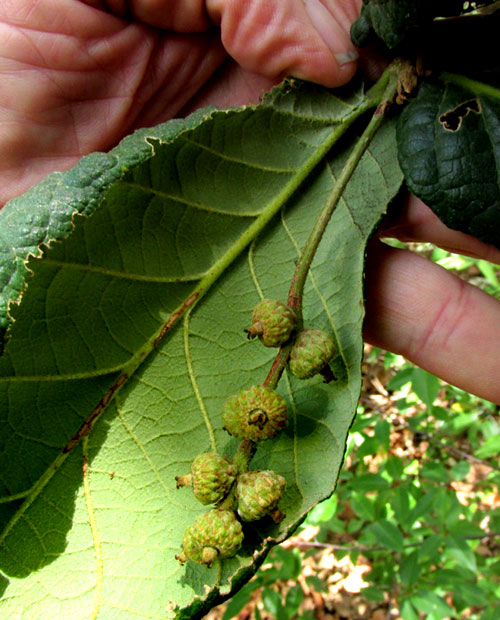
Seeing the long peduncle of the acorn cluster shown above I thought it might be a different species from the usual Quercus rugosa. But, no, apparently it's the same. The Flora del Bajío describes peduncle length as from (0.8)1.5 to 5(8) cm long, and these look like 7 or 8cm.